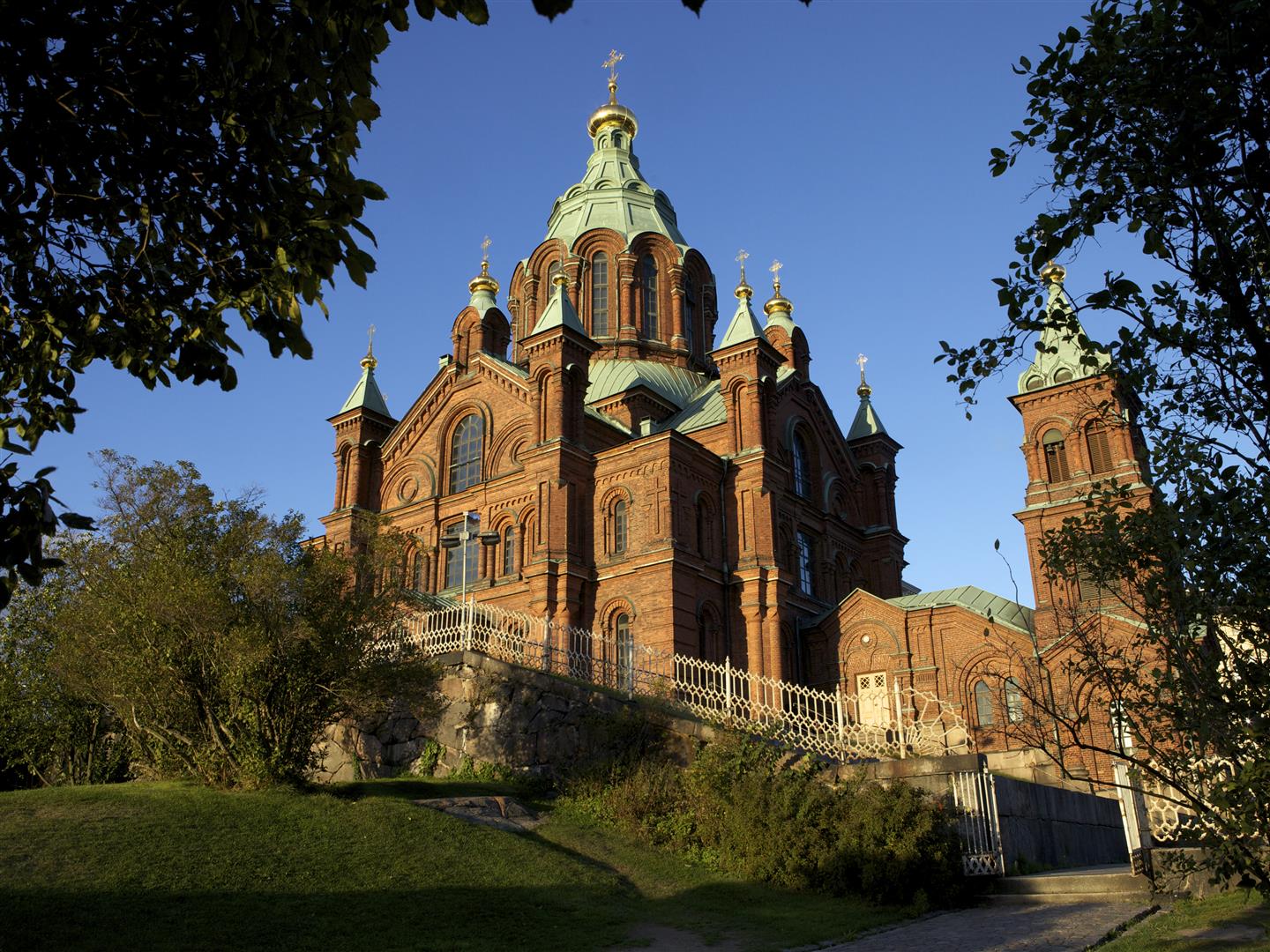
Attention: The admission fees at the cathedral start on 20th of May. Admission fee is 5 euros. Children under 18: free admission.
Opening times: www.uspenski.fi
The Uspenski Cathedral is the main cathedral of the Orthodox Parish of Helsinki and the Diocese of Helsinki – their center of worship. It is also one of the most important attractions in Helsinki and a venue for numerous concerts every year. The cathedral receives approximately half a million visitors every year.
The Uspenski Cathedral is considered to be the largest Orthodox temple in Northern and Western Europe. The cathedral’s size is emphasized by its location on the highest hill of the Katajanokka district. The central cupola of the cathedral is 33 meters high.
The cathedral was designed by the Russian church architect Aleksei M. Gornostajev. The Uspenski Cathedral was consecrated on October 25th, 1868.
The Uspenski Cathedral is consecrated to the Dormition of the Mother of God (uspenie).
The praasniekka church festival (also known as prazdnik or kermis) is held annually on August 15th.
History of the Cathedral
The Uspenski Cathedral was consecrated on October 25th, 1868. According to the wishes of Alexander II, the Emperor of Russia, the cathedral was consecrated to the Dormition of the Mother of God (uspenie).
At the time of the construction of the Uspenski Cathedral, in the 19th century, Finland was an autonomic Grand Duchy of the Russian Empire. The Orthodox Parish of Helsinki, founded in 1827, needed a larger church building for the growing orthodox population. The construction of the Uspenski Cathedral was funded mainly through donations from the parishioners and individual benefactors.
Architect A.M. Gornostajev designed the cathedral between 1859 and 1860, and initially led the construction work himself. After the death of Gornostajev in 1862, architect Ivan Varek was selected to continue Gornostajev’s work.
The design and construction of the Uspenski Cathedral took nine years. The bricks used in the construction were transported from the Bomarsund fortress in Åland, which was destroyed during the Crimean War.
The iconostasis of the cathedral was painted by the Russian artist and academic Pavel S. Šiltsov. The iconostasis is a combination of classic elements and Russian-Byzantine decorative motifs.
The Uspenski Cathedral was consecrated on October 25th, 1868. According to the wishes of Alexander II, the Emperor of Russia, the cathedral was consecrated to the Dormition of the Mother of God (uspenie).
Rauhankappeli
The Rauhankappeli chapel was erected in front of the Uspenski Cathedral to commemorate the 100-year anniversary of the Treaty of Fredrikshamn. The chapel was completed in 1913, but it was demolished already in 1920 by order of the Ministry of the Interior. An icon depicting the birth of Christ is located inside the Uspenski Cathedral as a memory of the Rauhankappeli chapel.
The Kozelshchyna wonderworking icon of the Mother of God
The icon is one of the greatest spiritual treasures of the Finnish Orthodox Church.
The Kozelshchyna wonderworking icon of the Mother of God is one of the greatest spiritual treasures of the Finnish Orthodox Church
The wonderworking icon was brought from Vyborg to Helsinki during the Second World War and placed inside the Uspenski Cathedral.
The icon and the donated jewelry surrounding it were stolen in June 2010. The man convicted of stealing the icon revealed its location to the police in February 2011. The icon was found in Turku, buried in the earth.
During the icon’s restoration, it was discovered that the icon was originally made in Poltava in 1885, and that it was a replica of the icon located in the Kozelshchyna monastery in Ukraine.
The icon was returned to the cathedral in August 2011. The icon could not be completely restored to its original condition. Most of the donated jewelry was stolen with the icon.
The commemoration day of the Kozelshchyna wonderworking icon of the Mother of God is held on February 21st.
Uspenski Cathedral renovations
The Uspenski Cathedral has been renovated several times during its 150-year history.
The Uspenski Cathedral has been renovated several times during its 150-year history.
The first renovation to the cathedral was done in the late 19th century. Antoniy, Finland’s first Orthodox Archbishop, consecrated the cathedral again on October 23rd 1893. The next major renovation to the cathedral was done for its 100-year anniversary.
Recent renovations have included the gilding of the cupolas and the tuning of the bells in 2004–2007, as well as the restoration of the celestial ceiling of the central cupola in 2015–2016.
Preparations are currently underway for the restoration of the iconostasis of the Uspenski Cathedral.
Photo: Katja Hagelstam

 Päivän sana
Päivän sana  Päivän pyhät
Päivän pyhät